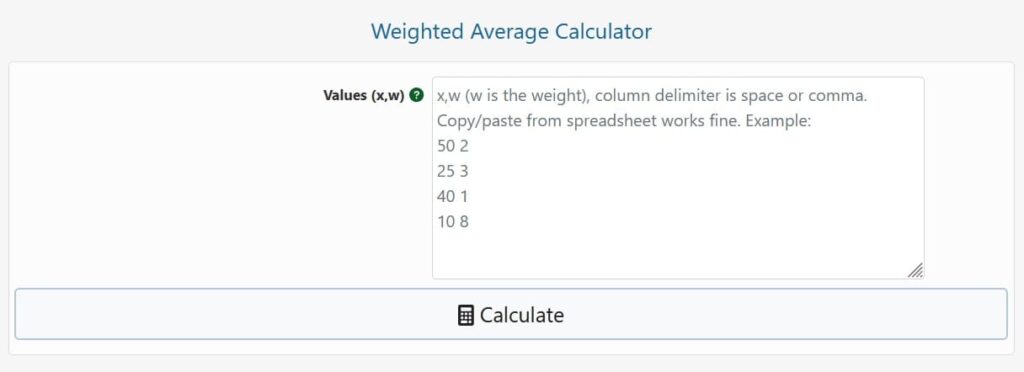
Menu


A weighted average (also known as a weighted mean) is a centrality measure in which some data points contribute more (or less) than others. When particular data points must be prioritised due to their relative value (e.g., in ranking tasks, indices, etc.) or when statistical measures from populations of varying sizes must be averaged, the weighted average is frequently used. Weighting marks for classes based on the number of credits they provide or their difficulty is an example of the former (as in weighted GPA). Averaging school grades across a number of school classes with various numbers of students is an example of the latter.Ordinary averages can be thought of as a type of weighted average in which all of the weights are equal.
Weights expressed on a scale of zero to one (0..1), percentages (0..100%), ranks, and other variables are supported by the weighted average calculator (1,3,5, etc.). It’s important to remember that weight values can’t be negative, and while some can be zero, at least one must be positive.
The following is the formula for calculating a weighted arithmetic mean:

where xi are the values of the variable X, wi are the related weights, and sigma is the symbol for the sum operation in Greek upper-case letters. This weighted mean equation can be expanded to make it easier to understand:

The formula outlines a procedure in which the values are multiplied by their weights iteratively, added together, and then divided by the sum of weights.
Calculating a weighted average grade (weighted GPA) from a number of classes or courses taken in high school or university is a popular application of weighted averages. Assume you have the following four classes, each with its own grade and number of credits:

Calculating a weighted average grade (weighted GPA) from a number of classes or courses taken in high school or university is a popular application of weighted averages. Assume you have the following four classes, each with its own grade and number of credits:
In this example, we’ll look at how to calculate the average score for laptop offerings from various manufacturers. Display quality, battery life, weight, CPU performance, and video card performance will all be weighted differently in the final score. In the form of a table:

The above weights indicate that the most emphasis is placed on display quality, with less emphasis on video card and battery life, and even less on weight and CPU power. Assuming five options with nearly similar prices and scores on each characteristic on a scale of 1 to 10, the table below calculates the weighted average score for each:

Using weighted scores generated using their weighted average to score many different laptops enables for simple comparison across all five areas by awarding a single score to each laptop. It’s worth noting that #3 and #4 have very different scores across the board yet the same weighted mean score. The same method can be used to select a university, a place of employment, a home/apartment, and so on.
© 2021 All rights reserved
Ask Your Query